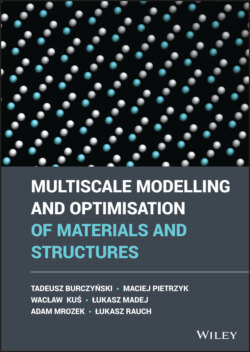Читать книгу Multiscale Modelling and Optimisation of Materials and Structures - Tadeusz Burczynski - Страница 11
1 Introduction to Multiscale Modelling and Optimization
ОглавлениеA wide selection of materials exhibits unusual in‐use properties gained by control of phenomena occurring in mesoscale, microscale, and nanoscale during manufacturing. Examples of such materials range from constructional steels (e.g. AHSS – Advanced High Strength Steels for automotive industry [8] and titanium alloys for aerospace industry [10]) through various materials for energy applications [6] to new biocompatible materials for ventricular assist devices [9] or other biomedical applications [11]. Due to potential advances in materials science that could dramatically affect the most innovative technologies, further development in this field is expected. For this to happen, materials science has to be supported by new tools and methodologies, among which numerical modelling plays a crucial role.
On the other hand, to predict the correlation between processing parameters and product properties properly, one needs to investigate macroscopic material behaviour and phenomena occurring at lower dimensional scales, at grain level or even at atomistic levels. Thus, multiscale modelling with the digital materials representation (DMR) concept [7] is a research field that potentially can support the design of new products with unique in‐use properties. The development of new materials modelling techniques that tackle various length scale phenomena is observed in many leading research institutes and universities worldwide. Multiscale analysis of length and temporal scales has already found a wide range of applications in many areas of science. Advantages provided by a combination of numerical approaches: finite element (FEM), crystal plasticity finite element (CPFEM), extended finite element (XFEM), finite volume (FVM), boundary element (BEM), meshfree, multigrid methods, Monte Carlo (MC), cellular automata (CA), molecular dynamics (MD), molecular statics (MS), phase field and level set methods, fast Fourier transformation, etc. are already being successfully applied in practical applications [14].
This book's main feature, which distinguishes it from other publications, is that it is focused on modelling of processing of materials and that it combines the problem of multiscale modelling with the optimization tasks providing a wide range of possibilities for practical industrial applications.
The first part of the book contains a presentation of basic principles of the microscale and nanoscale modelling techniques. The second part supplies information about applications of optimization and identification techniques in multiscale modelling. The book is recapitulated by presenting information on the computer science techniques used in multiscale modelling, and it is focused on computer implementation issues, advising scientists interested in developing their multiscale models.
